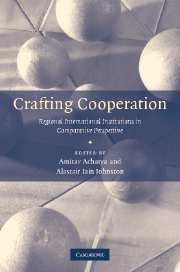Book contents
- Frontmatter
- Contents
- List of tables
- Notes on the contributors
- Acknowledgments
- 1 Comparing regional institutions: an introduction
- 2 Hanging together, institutional design, and cooperation in Southeast Asia: AFTA and the ARF
- 3 International cooperation in Latin America: the design of regional institutions by slow accretion
- 4 Crafting regional cooperation in Africa
- 5 Functional form, identity-driven cooperation: institutional designs and effects in post-Cold War NATO
- 6 Designed to fail or failure of design? The origins and legacy of the Arab League
- 7 Social mechanisms and regional cooperation: are Europe and the EU really all that different?
- 8 Conclusion: institutional features, cooperation effects, and the agenda for further research on comparative regionalism
- Bibliography
- Index
7 - Social mechanisms and regional cooperation: are Europe and the EU really all that different?
Published online by Cambridge University Press: 22 September 2009
- Frontmatter
- Contents
- List of tables
- Notes on the contributors
- Acknowledgments
- 1 Comparing regional institutions: an introduction
- 2 Hanging together, institutional design, and cooperation in Southeast Asia: AFTA and the ARF
- 3 International cooperation in Latin America: the design of regional institutions by slow accretion
- 4 Crafting regional cooperation in Africa
- 5 Functional form, identity-driven cooperation: institutional designs and effects in post-Cold War NATO
- 6 Designed to fail or failure of design? The origins and legacy of the Arab League
- 7 Social mechanisms and regional cooperation: are Europe and the EU really all that different?
- 8 Conclusion: institutional features, cooperation effects, and the agenda for further research on comparative regionalism
- Bibliography
- Index
Summary
Introduction
Many analysts would characterize the European Union (EU) as a unique case among the panoply of regional organizations, with a level of cooperation that is wider and deeper than elsewhere. Moreover, recent years have witnessed a seeming acceleration of the Union's uniqueness. A common currency has been successfully introduced, a constitutional convention held, and a (supranational) constitution is now up for adoption. In social science terms, it would seem that actors have undertaken major adjustments in favor of group norms through the internalization of shared preferences and normative understandings.
The key word in that last sentence is “seem,” for there is broad disagreement across the EU literature on this basic issue. In part, this is simply a function of analysts employing different social-theoretic toolkits (contractionalist-rationalist versus sociological) to structure their studies. However, equally important is a state of affairs where normative claim-making and abstract theorizing have outrun carefully designed and methodologically sound empirical studies.
To be fair to EU scholars, their object of study is extraordinarily complex and is a moving target. The degree of cooperation varies tremendously depending upon the institution (the supranational Commission versus the intergovernmental Council, say) or policy area studied. Moreover, EU institutions have evolved significantly over the past half century, in directions often at variance with the original desires of the member states.
- Type
- Chapter
- Information
- Crafting CooperationRegional International Institutions in Comparative Perspective, pp. 221 - 243Publisher: Cambridge University PressPrint publication year: 2007
- 3
- Cited by

